2020 NISSAN ALTIMA light
[x] Cancel search: lightPage 505 of 559
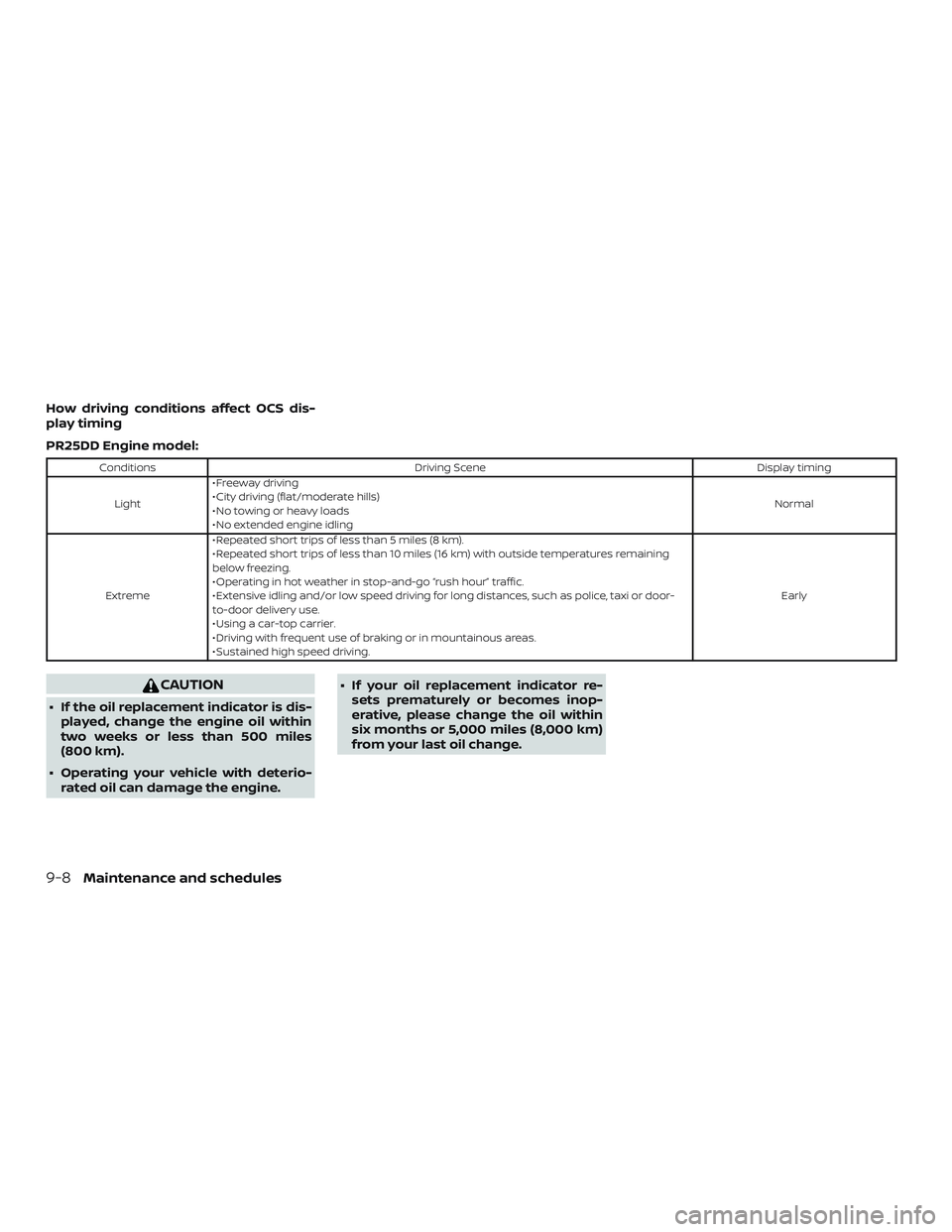
How driving conditions affect OCS dis-
play timing
PR25DD Engine model:
ConditionsDriving Scene Display timing
Light ∙ Freeway driving
∙ City driving (flat/moderate hills)
∙ No towing or heavy loads
∙ No extended engine idling Normal
Extreme ∙ Repeated short trips of less than 5 miles (8 km).
∙ Repeated short trips of less than 10 miles (16 km) with outside temperatures remaining
below freezing.
∙ Operating in hot weather in stop-and-go “rush hour” traffic.
∙ Extensive idling and/or low speed driving for long distances, such as police, taxi or door-
to-door delivery use.
∙ Using a car-top carrier.
∙ Driving with frequent use of braking or in mountainous areas.
∙ Sustained high speed driving. Early
CAUTION
∙ If the oil replacement indicator is dis-
played, change the engine oil within
two weeks or less than 500 miles
(800 km).
∙ Operating your vehicle with deterio- rated oil can damage the engine. ∙ If your oil replacement indicator re-
sets prematurely or becomes inop-
erative, please change the oil within
six months or 5,000 miles (8,000 km)
from your last oil change.
9-8Maintenance and schedules
Page 506 of 559
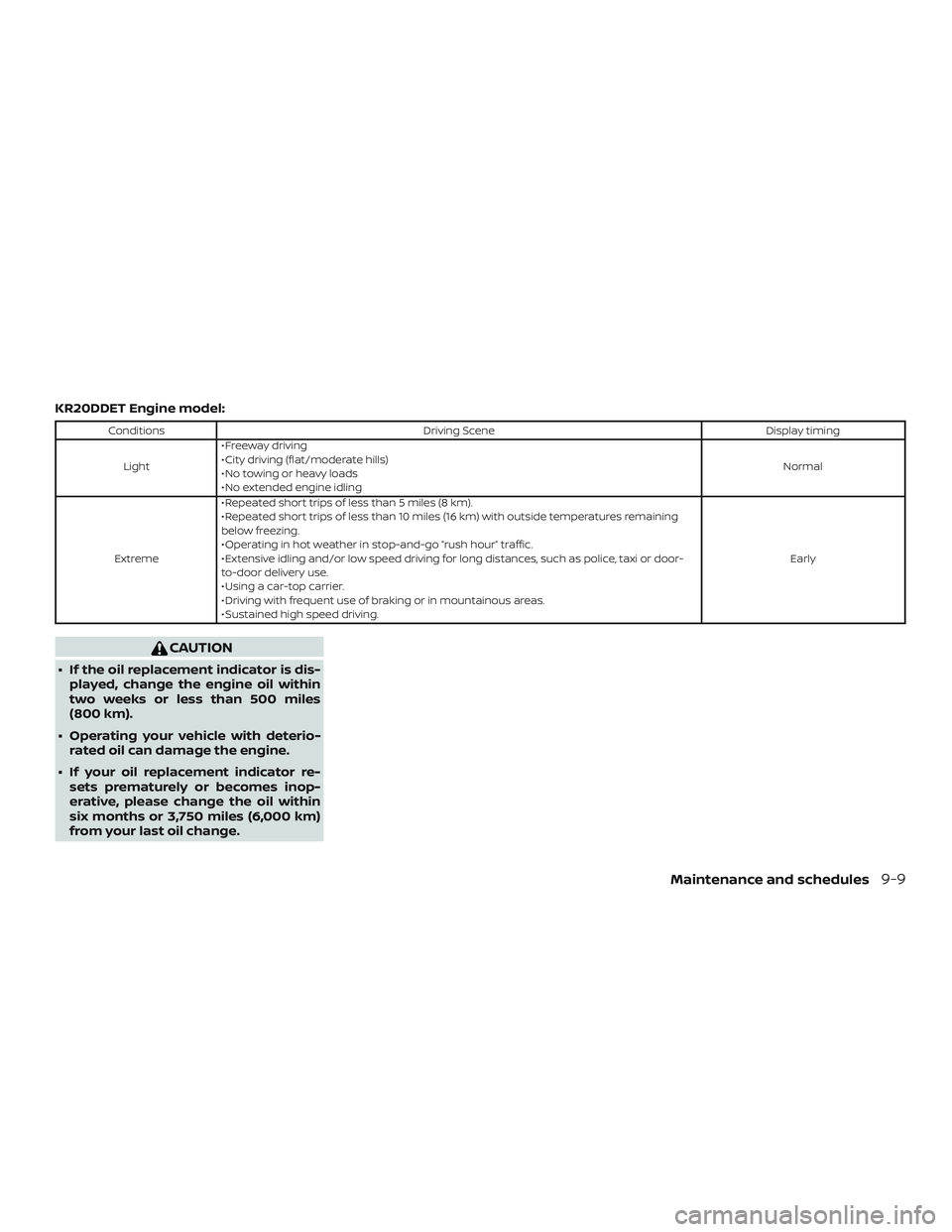
KR20DDET Engine model:
ConditionsDriving Scene Display timing
Light ∙ Freeway driving
∙ City driving (flat/moderate hills)
∙ No towing or heavy loads
∙ No extended engine idling Normal
Extreme ∙ Repeated short trips of less than 5 miles (8 km).
∙ Repeated short trips of less than 10 miles (16 km) with outside temperatures remaining
below freezing.
∙ Operating in hot weather in stop-and-go “rush hour” traffic.
∙ Extensive idling and/or low speed driving for long distances, such as police, taxi or door-
to-door delivery use.
∙ Using a car-top carrier.
∙ Driving with frequent use of braking or in mountainous areas.
∙ Sustained high speed driving. Early
CAUTION
∙ If the oil replacement indicator is dis-
played, change the engine oil within
two weeks or less than 500 miles
(800 km).
∙ Operating your vehicle with deterio- rated oil can damage the engine.
∙ If your oil replacement indicator re- sets prematurely or becomes inop-
erative, please change the oil within
six months or 3,750 miles (6,000 km)
from your last oil change.
Maintenance and schedules9-9
Page 523 of 559
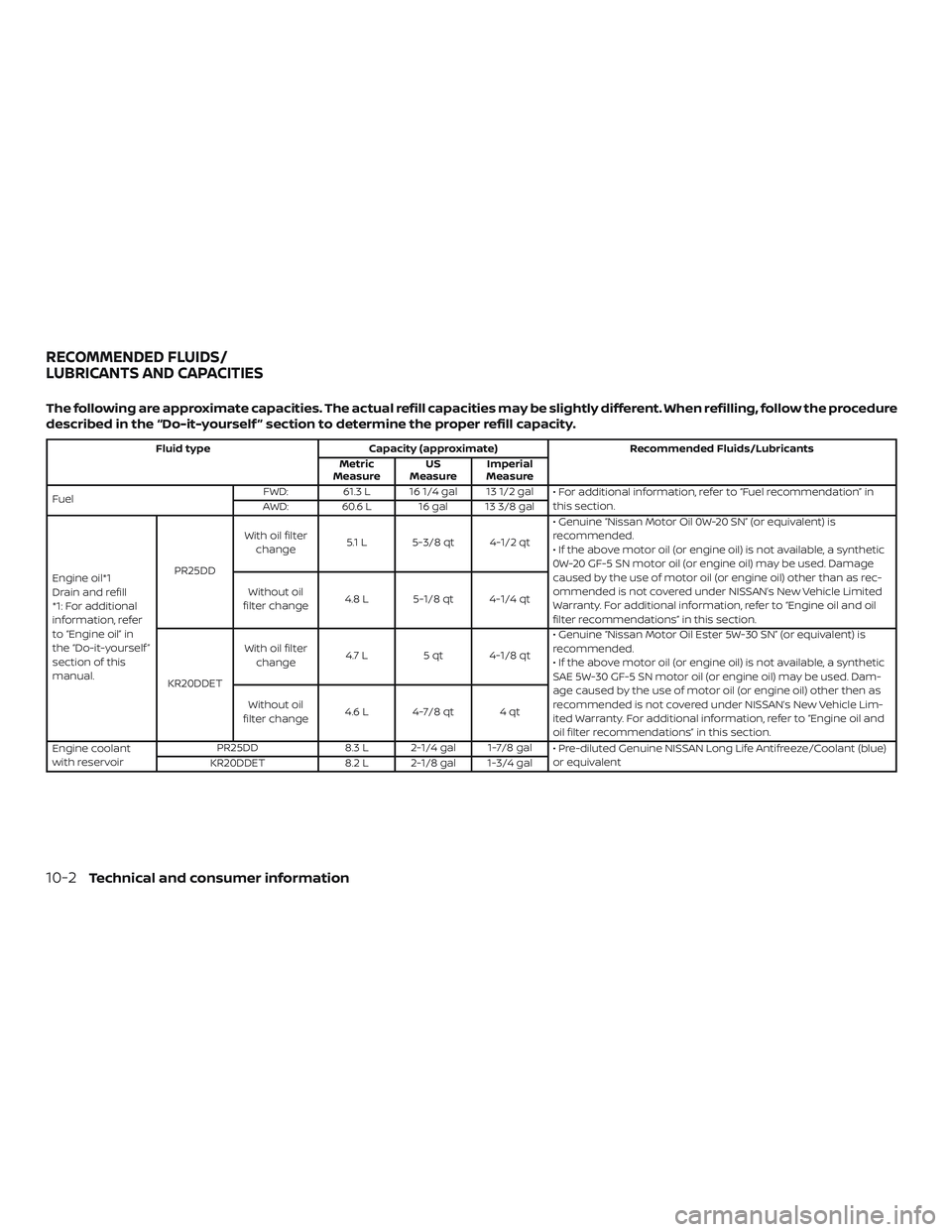
The following are approximate capacities. The actual refill capacities may be slightly different. When refilling, follow the procedure
described in the “Do-it-yourself ” section to determine the proper refill capacity.
Fluid typeCapacity (approximate) Recommended Fluids/Lubricants
Metric
Measure US
Measure Imperial
Measure
Fuel FWD:
61.3 L 16 1/4 gal 13 1/2 gal
• For additional information, refer to “Fuel recommendation” in
this section.
AWD: 60.6 L 16 gal 13 3/8 gal
Engine oil*1
Drain and refill
*1: For additional
information, refer
to “Engine oil” in
the “Do-it-yourself ”
section of this
manual. PR25DD
With oil filter
change 5.1 L 5-3/8 qt 4-1/2 qt • Genuine “Nissan Motor Oil 0W-20 SN” (or equivalent) is
recommended.
• If the above motor oil (or engine oil) is not available, a synthetic
0W-20 GF-5 SN motor oil (or engine oil) may be used. Damage
caused by the use of motor oil (or engine oil) other than as rec-
ommended is not covered under NISSAN’s New Vehicle Limited
Warranty. For additional information, refer to “Engine oil and oil
filter recommendations” in this section.
Without oil
filter change 4.8 L 5-1/8 qt 4-1/4 qt
KR20DDET With oil filter
change 4.7 L
5 qt 4-1/8 qt • Genuine “Nissan Motor Oil Ester 5W-30 SN” (or equivalent) is
recommended.
• If the above motor oil (or engine oil) is not available, a synthetic
SAE 5W-30 GF-5 SN motor oil (or engine oil) may be used. Dam-
age caused by the use of motor oil (or engine oil) other then as
recommended is not covered under NISSAN’s New Vehicle Lim-
ited Warranty. For additional information, refer to “Engine oil and
oil filter recommendations” in this section.
Without oil
filter change 4.6 L 4-7/8 qt 4 qt
Engine coolant
with reservoir PR25DD
8.3 L 2-1/4 gal 1-7/8 gal
• Pre-diluted Genuine NISSAN Long Life Antifreeze/Coolant (blue)
or equivalent
KR20DDET 8.2 L 2-1/8 gal 1-3/4 gal
RECOMMENDED FLUIDS/
LUBRICANTS AND CAPACITIES
10-2Technical and consumer information
Page 527 of 559
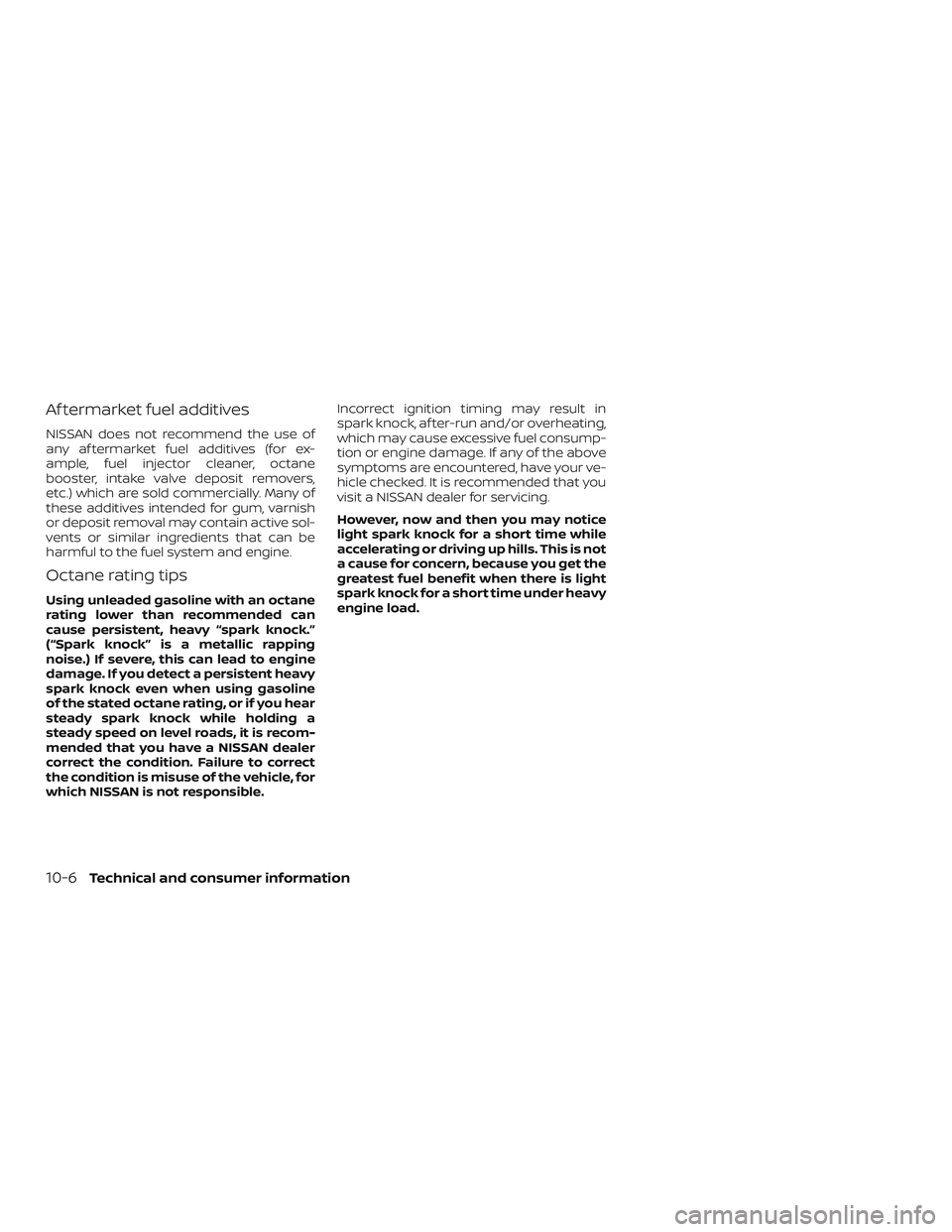
Af termarket fuel additives
NISSAN does not recommend the use of
any af termarket fuel additives (for ex-
ample, fuel injector cleaner, octane
booster, intake valve deposit removers,
etc.) which are sold commercially. Many of
these additives intended for gum, varnish
or deposit removal may contain active sol-
vents or similar ingredients that can be
harmful to the fuel system and engine.
Octane rating tips
Using unleaded gasoline with an octane
rating lower than recommended can
cause persistent, heavy “spark knock.”
(“Spark knock” is a metallic rapping
noise.) If severe, this can lead to engine
damage. If you detect a persistent heavy
spark knock even when using gasoline
of the stated octane rating, or if you hear
steady spark knock while holding a
steady speed on level roads, it is recom-
mended that you have a NISSAN dealer
correct the condition. Failure to correct
the condition is misuse of the vehicle, for
which NISSAN is not responsible.Incorrect ignition timing may result in
spark knock, af ter-run and/or overheating,
which may cause excessive fuel consump-
tion or engine damage. If any of the above
symptoms are encountered, have your ve-
hicle checked. It is recommended that you
visit a NISSAN dealer for servicing.
However, now and then you may notice
light spark knock for a short time while
accelerating or driving up hills. This is not
a cause for concern, because you get the
greatest fuel benefit when there is light
spark knock for a short time under heavy
engine load.
10-6Technical and consumer information
Page 542 of 559
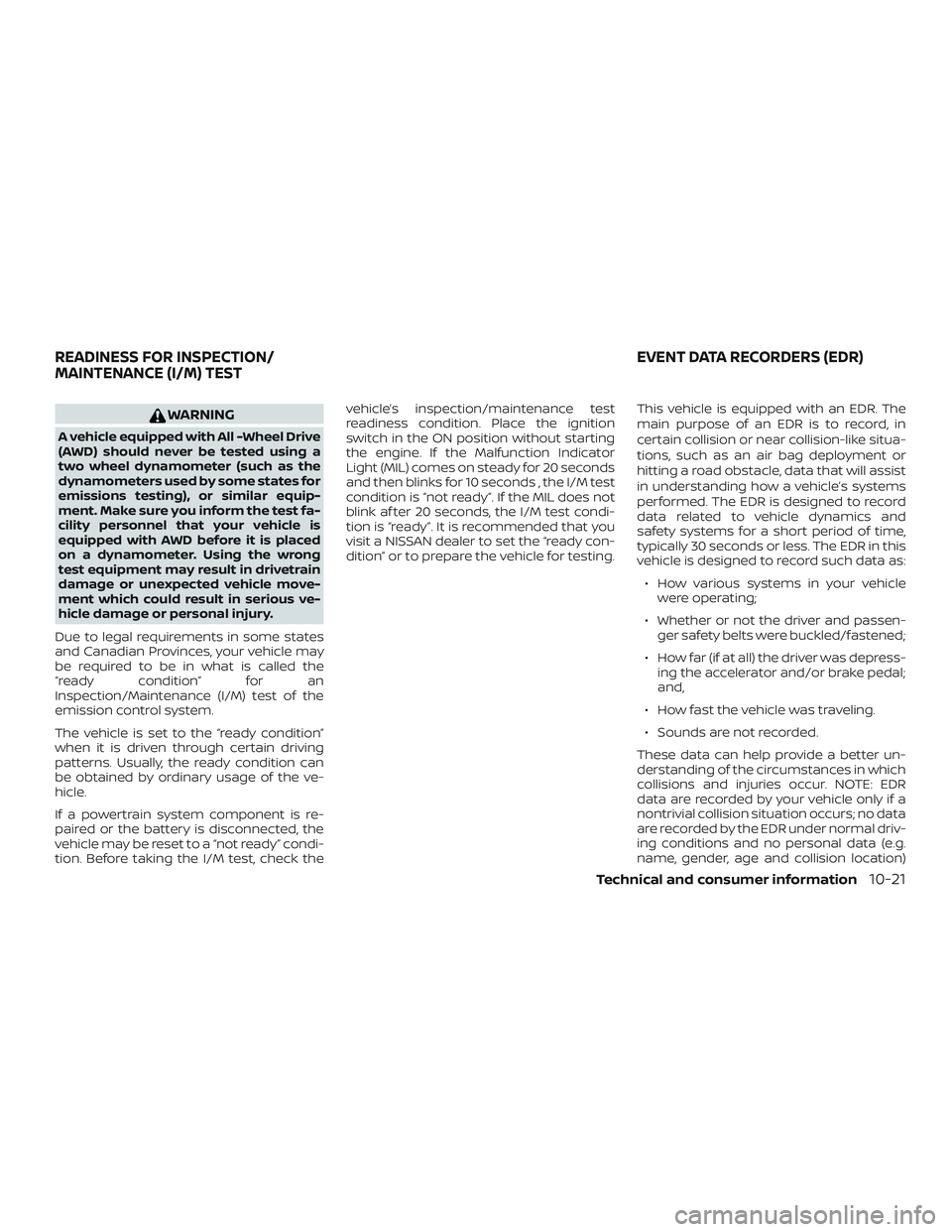
WARNING
A vehicle equipped with All -Wheel Drive
(AWD) should never be tested using a
two wheel dynamometer (such as the
dynamometers used by some states for
emissions testing), or similar equip-
ment. Make sure you inform the test fa-
cility personnel that your vehicle is
equipped with AWD before it is placed
on a dynamometer. Using the wrong
test equipment may result in drivetrain
damage or unexpected vehicle move-
ment which could result in serious ve-
hicle damage or personal injury.
Due to legal requirements in some states
and Canadian Provinces, your vehicle may
be required to be in what is called the
“ready condition” for an
Inspection/Maintenance (I/M) test of the
emission control system.
The vehicle is set to the “ready condition”
when it is driven through certain driving
patterns. Usually, the ready condition can
be obtained by ordinary usage of the ve-
hicle.
If a powertrain system component is re-
paired or the battery is disconnected, the
vehicle may be reset to a “not ready” condi-
tion. Before taking the I/M test, check the vehicle’s inspection/maintenance test
readiness condition. Place the ignition
switch in the ON position without starting
the engine. If the Malfunction Indicator
Light (MIL) comes on steady for 20 seconds
and then blinks for 10 seconds , the I/M test
condition is “not ready”. If the MIL does not
blink af ter 20 seconds, the I/M test condi-
tion is “ready”. It is recommended that you
visit a NISSAN dealer to set the “ready con-
dition” or to prepare the vehicle for testing.
This vehicle is equipped with an EDR. The
main purpose of an EDR is to record, in
certain collision or near collision-like situa-
tions, such as an air bag deployment or
hitting a road obstacle, data that will assist
in understanding how a vehicle’s systems
performed. The EDR is designed to record
data related to vehicle dynamics and
safety systems for a short period of time,
typically 30 seconds or less. The EDR in this
vehicle is designed to record such data as:
∙ How various systems in your vehicle were operating;
∙ Whether or not the driver and passen- ger safety belts were buckled/fastened;
∙ How far (if at all) the driver was depress- ing the accelerator and/or brake pedal;
and,
∙ How fast the vehicle was traveling.
∙ Sounds are not recorded.
These data can help provide a better un-
derstanding of the circumstances in which
collisions and injuries occur. NOTE: EDR
data are recorded by your vehicle only if a
nontrivial collision situation occurs; no data
are recorded by the EDR under normal driv-
ing conditions and no personal data (e.g.
name, gender, age and collision location)
READINESS FOR INSPECTION/
MAINTENANCE (I/M) TEST EVENT DATA RECORDERS (EDR)
Technical and consumer information10-21
Page 546 of 559
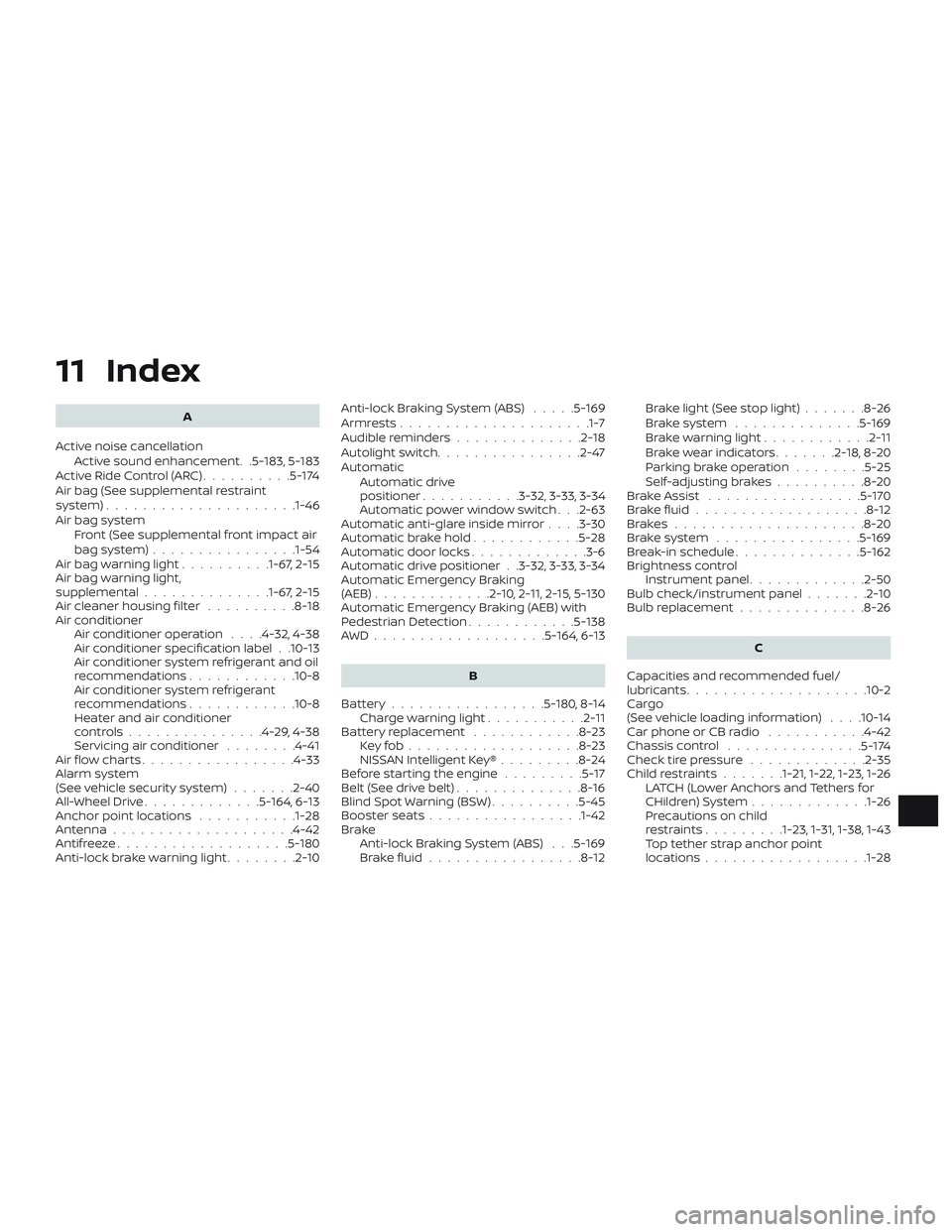
11 Index
A
Active noise cancellation Active sound enhancement. .5-183, 5-183
ActiveRideControl(ARC)..........5-174
Air bag (See supplemental restraint
system) .................... .1-46
Air bag system Front (See supplemental front impact air
bagsystem)............... .1-54
Airbagwarninglight..........1-67, 2-15
Air bag warning light,
supplemental ..............1-67, 2-15
Air cleaner housing filter ..........8-18
Air conditioner Air conditioner operation ....4-32,4-38
Air conditioner specification label . .10-13
Air conditioner system refrigerant and oil
recommendations ............10-8
Air conditioner system refrigerant
recommendations ............10-8
Heater and air conditioner
controls...............4-29,4-38
Servicing air conditioner ........4-41
Air flow charts .................4-33
Alarm system
(See vehicle security system) .......2-40
All-Wheel Drive .............5-164,6-13
Anchor point locations ...........1-28
Antenna ....................4-42
Antifreeze ...................5-180
Anti-lock brake warning light ........2-10Anti-lock Braking System (ABS)
.....5-169
Armrests.................... .1-7
Audible reminders ..............2-18
Autolightswitch................2-47
Automatic Automatic drive
positioner ...........3-32,3-33,3-34
Automatic power window switch . . .2-63
Automatic anti-glare inside mirror ....3-30
Automaticbrakehold............5-28
Automatic door locks .............3-6
Automatic drive positioner . .3-32, 3-33, 3-34
Automatic Emergency Braking
(AEB) .............2-10,2 -11, 2-15, 5-130
Automatic Emergency Braking (AEB) with
Pedestrian Detection ............5-138
AWD...................5-164,6-13
B
Battery.................5-180,8-14 Charge warning light ...........2-11
Battery replacement ............8-23
Keyfob...................8-23
NISSAN Intelligent Key® .........8-24
Before starting the engine .........5-17
Belt(Seedrivebelt)..............8-16
Blind Spot Warning (BSW) ..........5-45
Booster seats .................1-42
Brake Anti-lock Braking System (ABS) . . .5-169
Brakefluid.................8-12 Brakelight(Seestoplight).......8-26
Brakesystem ..............5-169
Brakewarninglight............2-11
Brakewearindicators.......2-18,8-20
Parking brake operation
........5-25
Self-adjustingbrakes..........8-20
Brake Assist .................5-170
Brakefluid...................8-12
Brakes.....................8-20
Brakesystem ................5-169
Break-in schedule ..............5 -162
Brightness control Instrument panel .............2-50
Bulb check/instrument panel .......2-10
Bulb replacement .............. 8-26
C
Capacities and recommended fuel/
lubricants....................10-2
Cargo
(See vehicle loading information) . . . .10-14
Car phone or CB radio ...........4-42
Chassis control ...............
5-174
Check tire pressure .............2-35
Childrestraints.......1-21, 1-22, 1-23, 1-26 LATCH (Lower Anchors and Tethers for
CHildren)System.............1-26
Precautions on child
restraints.........1-23, 1-31, 1-38, 1-43
Top tether strap anchor point
locations..................1-28
Page 547 of 559

Child safety rear door lock..........3-7
Chimes, audible reminders .........2-18
Cleaningexteriorandinterior......7-2,7-5
C.M.V.S.S. certification label .........10-12
Coldweatherdriving ............5-180
Console box ..................2-59
Continuously Variable Transmission
(CVT) .......................5-18
Continuously Variable Transmission
(CVT) fluid ..................8-12
Driving with Continuously Variable
Transmission (CVT) ............5-18
Controls Heater and air conditioner
controls................4-29,4-38
Coolant Capacities and recommended
fuel/lubricants...............10-2
Changing engine coolant .........8-6
Checking engine coolant level ......8-6
Engine coolant temperature gauge . .2-6
Corrosionprotection..............7-8
Cruisecontrol .................5-63
Cupholders ...............2-60,2-61
D
Daytime Running Light System ......2-50
Defroster switch Rear window and outside mirror
defrosterswitch..............2-44
Dimensions and weights ..........10-10
Dimmer switch for instrument panel . . .2-50
Door locks ....................3-4
Drivebelt ....................8-16 Drive positioner, Automatic . . .3-32, 3-33, 3-34
Driving
Cold weather driving ..........5-180
Driving with Continuously Variable
Transmission (CVT) ............5-18
Precautions when starting and
driving..................5-4,5-11
Drivingthevehicle...............5-18
E
E-call (SOS) Button ..............2-54
Economy - fuel ................5-164
Emergency engine shutoff .......5-15,6-2
Emission control information label . . . .10-13
Emission control system warranty . . . .10-19
Engine Before starting the engine ........5-17
Capacities and recommended
fuel/lubricants...............10-2
Changing engine coolant .........8-6
Changing engine oil ............8-8
Changing engine oil filter .........8-8
Checking engine coolant level ......8-6
Checking engine oil level .........8-7
Engine compartment check
locations...................8-3
Engine coolant temperature gauge . .2-6
Engine cooling system ..........8-5
Engine oil ...................8-7
Engine oil and oil filter
recommendation .............10-7
Engine oil pressure warning light ....2-12
Engine oil viscosity .............10-7
Engine serial number ..........10-12 Engine specifications
...........10-9
Starting the engine ............5-17
Engine Block Heater .............5-182
Engine coolant temperature gauge ....2-6
EventDatarecorders.........10-21,10-22
Exhaust gas (Carbon monoxide) .......5-4
Explanation of maintenance items .....9-2
Explanation of scheduled maintenance
items .......................9-5
Extended storage switch ..........2-57
Eyeglasscase.................2-59
F
Flashers
(Seehazardwarningflasherswitch)....6-2
Flattire....................6-3,6-4
Floormatpositioningaid...........7-6
Fluid Brakefluid..................8-12
Capacities and recommended
fuel/lubricants...............10-2
Continuously Variable Transmission (CVT)
fluid......................8-12
Engine coolant ...............8-5
Engine oil ...................8-7
Windshield-washer fluid .........8-13
F
.M.V.S.S. certification label .........10-12
Foglightswitch ................2-51
Front air bag system
(See supplemental restraint system) . . .1-54
Front-door pocket ..............2-58
Front power seat adjustment ........1-4
Frontseats....................1-2
11-2
Page 548 of 559

FuelCapacities and recommended
fuel/lubricants...............10-2
Fuel economy ...............5-164
Fuel-filler door and cap ..........3-25
Fuel-filler door lock opener lever ....3-25
Fuel gauge ..................2-7
Fueloctanerating.............10-6
Fuel recommendation ..........10-4
Loose fuel cap warning .........2-35
Fuelefficientdrivingtips ..........5-163
Fuel-filler door .................3-25
Fuel gauge ....................2-7
Fuses .......................8-21
Fusiblelinks...................8-22
G
Garage door opener, HomeLink® Universal
Transceiver . . .2-67, 2-68, 2-69, 2-70, 2-70, 2-71
Gascap.....................3-25
Gauge Engine coolant temperature gauge . .2-6
Fuel gauge ..................2-7
Odometer ..................2-5
Speedometer ..............2-4,2-5
Tachometer .................2-6
Trip odometer .............2-4,2-5
General maintenance .............9-2
Glovebox....................2-59
Gloveboxlock.................2-59 H
Hazard warning flasher switch ........6-2
Headlight and turn signal switch ......2-45
Headlightcontrolswitch...........2-45
Headlights ...................8-25
Headrestraints................. .1-7
Heated seat switches ............2-52
Heated steering wheel ............2-53
Heater Heater and air conditioner
controls................4-29,4-38
Heater operation ..........4-30,4-39
Hill start assist system ............5-174
HomeLink® Universal
Transceiver . . .2-67, 2-68, 2-69, 2-70, 2-70, 2-71
Hood .......................3-22
Horn.......................2-52
I
Ignition switch Push-button ignition switch .......5-13
Immobilizer system ..........2-42,5-16
Important vehicle information label . . .10-12
In-cabinmicrofilter..............8-18
Increasing fuel economy ..........5-164
Indicator NISSAN Intelligent Key® battery discharge
indicator...................5-16
Indicator lights and audible reminders
(See warning/indicator lights and audible
reminders) ....................2-15
Inside automatic anti-glare mirror .....3-30
Instrument brightness control .......2-50Instrument panel
.............0-6,2-2
Instrument panel dimmer switch .....2-50
Intelligent Around View Monitor .......4-11
Intelligent Cruise Control (ICC)
(for vehicles without ProPILOT Assist) . . .5-66
Intelligent Cruise Control (ICC)
(for vehicles with ProPILOT Assist) . . . .5-102
Intelligent Driver Alertness (I-DA) .....5-159
Intelligent Forward Collision Warning
(I-FCW) .................... .5-147
Intelligent Key system Key operating range ............3-9
Key operation ................3-10
Mechanical key ...............3-3
Remote keyless entry operation ....3-14
Troubleshooting guide ..........3-17
Warning signals ...............3-17
Intelligent Lane Intervention (I-LI) .....5-39
Intelligent Trace Control (I-TC) .......5-174
Interiorlight...................2-66
I
nteriortrunklidrelease...........3-24
ISOFIX child restraints .............1-26
J
Jumpstarting...............6-9,8-15
K
Key........................ .3-2
Key fob battery replacement ........8-23
Keyless entry With Intelligent Key system
(See Intelligent Key system) .......3-14
11-3